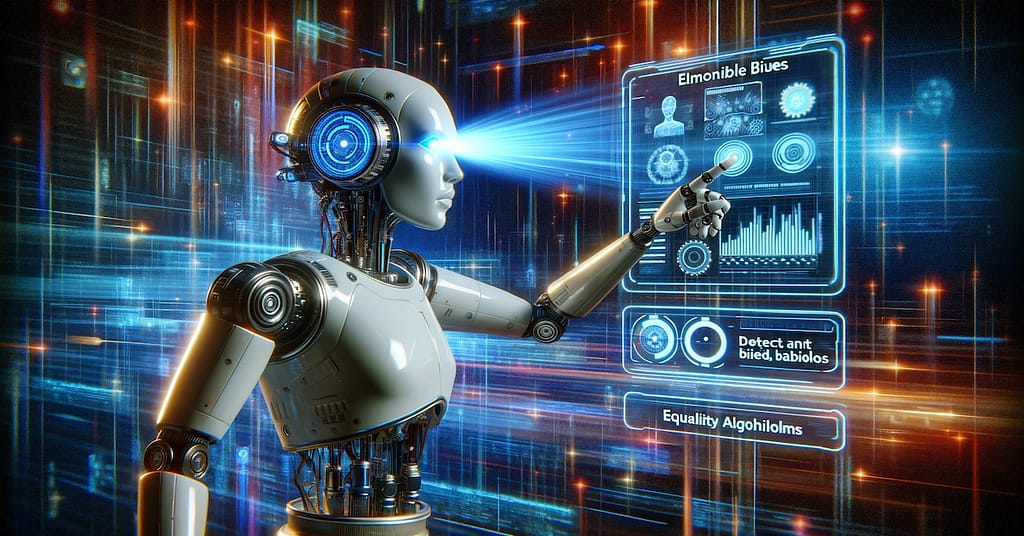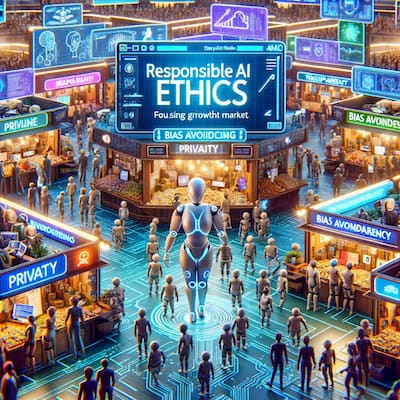Hey there! Let’s talk about something you’ve likely bumped into on a website or two: chatbots. These digital buddies have come a long way, and nowadays, they’re not just responding to simple queries – they’re becoming incredibly sophisticated, often indistinguishable from chatting with a human. But with great power comes great responsibility, right? That’s why we’re going to dive deep into responsible AI in chatbots.
As we’re witnessing chatbots getting smarter by the day, there’s a growing conversation we can’t afford to skip: ethics in chatbot development. Let’s chat about something super important in the world of chatbots. Sure, we want our digital pals to be super-efficient, but there’s more to it. We’ve got to build them the right way – responsibly and ethically. We’re diving deep into some key stuff here, like making sure they’re transparent, accountable, fair, and, oh-so-important, really careful with our privacy. So, grab your seat – we’re taking a trip into the exciting and thoughtful world of ethical AI in chatbots.
The Need for Transparency and Accountability in Chatbot Development

Alright, let’s chat about two big words in the chatbot world: transparency and accountability. These aren’t just buzzwords; they’re the foundation of trust and ethical practice in chatbot development.
What’s the Deal with Transparency?
When we talk about transparency in chatbots, we mean peeling back the curtain and letting users see the wizard behind the machine. It’s about being clear on how chatbots collect and use data, how they make decisions, and ensuring users aren’t left in the dark. This clarity is crucial because, let’s face it, nobody likes to feel like they’re talking to a mysterious black box. Transparency builds trust, and trust is gold in the digital world.
Accountability: The Unsung Hero
Accountability goes hand in hand with transparency. It’s about taking responsibility for how these chatbots behave. Are they fair? Are they respectful of privacy? Holding chatbot developers accountable means ensuring these digital helpers are not just smart but also ethical and responsible.
Achieving Transparency and Accountability
So, how do companies get this right? It’s like baking a cake – you need the right ingredients and a good recipe. For starters, be open about where your data comes from. It’s like showing the ingredients list on your food packaging. Next, give users the reins – let them control their data and understand how the chatbot works. And don’t forget to publish your ethical guidelines, kind of like a chef sharing their secret sauce recipe.
Diving Deeper: Responsible AI in Chatbots
As chatbots become more like our digital sidekicks, we need to think about the ethical side of things. Are our chatbot buddies accidentally learning biases? Are they keeping our secrets safe? When we talk about these ethical puzzles, it’s not just about dodging problems. It’s really about creating chatbots that do more than just the basics – we’re aiming for ones that truly make our lives better and brighter.

Cutting Bias Out of the Picture
Biases in chatbots can sneak in through the back door – in the data, the algorithms, even in how they’re set loose in the world. Tackling this means playing detective – using diverse data sets, hunting down biases, and always keeping a human in the loop to keep things in check.
Making Chatbots Clear as Crystal
Transparency isn’t just about honesty; it’s also about making things clear and understandable. Users should be able to get why a chatbot made a certain call or what’s going on under the hood. It’s about making complex AI stuff user-friendly.
Keeping User Privacy Sacred
In the world of chatbots, user data is a treasure trove. But with great data comes great responsibility. Keeping user privacy in check is all about being extra cautious with how we gather, keep, and use personal info. It’s like playing by the privacy rulebook and making sure everyone gets to manage their own digital footprints. Think of it as giving users the keys to their own online kingdom.
Mitigating Bias in Chatbots
Alright, let’s tackle a tough topic in the chatbot world: bias. It’s like that sneaky ingredient that can spoil the whole dish if we’re not careful. When chatbots get biased, they can end up doing more harm than good, like giving skewed advice or making unfair decisions. So, what’s the deal with bias in chatbots, and how do we keep it at bay?

Bias in Chatbots: A Tricky Customer
Bias in chatbots is like a chatbot having a secret favorite. It might start preferring one type of user over another or responding differently based on hidden prejudices. And here’s the kicker: this bias can sneak in at any stage – when collecting data, during training, or even when the chatbot is out there chatting with users. The result? Some users might get the short end of the stick, and that’s not cool.
The Bias Boogie: Where It Begins
So, where does this bias come from? Imagine you’re training a chatbot with data that’s not really a good mix of what the world looks like. It’s like teaching someone to cook with only one kind of spice – they won’t be ready for all the flavors out there. This lack of diversity can lead to chatbots making assumptions or missing the mark.
Fighting Bias: The Chatbot Diet
To get our chatbots on the straight and narrow, we’ve got a few tricks up our sleeves. First, mix up that data diet – use diverse and representative data sets. Then, bring in some smart bias detection algorithms to sniff out any unfairness. And don’t forget about good old human oversight – sometimes, there’s no substitute for a human touch to make sure things are on track.
Real-World Oopsies and Fixes

Let’s talk real talk – there have been some facepalm moments with biased chatbots. Like that time a chatbot started making some not-so-great assumptions about people’s jobs based on gender – yikes! But here’s the good news: these slip-ups were tackled head-on. By retraining with better data and keeping a closer human eye on things, these chatbots got back on track.
Responsible Chatbot Development: The To-Do List
Want to keep your chatbot in the ethical green zone? Here’s a checklist:
- Diverse Data Sets: Mix it up with your data to give your chatbot a well-rounded view.
- Bias Detection and Mitigation: Use those smart algorithms and human checks to keep bias in check.
- Clear Communication: Be upfront with users about what your chatbot can and can’t do.
- User Control: Empower users to have a say in their chatbot interactions.
- Human Oversight: Keep a human in the loop to ensure everything’s kosher.
Protecting User Privacy in the World of Chatbots
Let’s switch gears and talk about something that’s super important in our digital world: user privacy, especially when it comes to chatbots. Our digital buddies, these chatbots, are champs at gathering and analyzing data to simplify our lives. But remember the saying, “With great power comes great responsibility?” Well, with great data, it’s the same deal. The big question is, how do we ensure these friendly chatbots are playing nice with our privacy?
Chatbots and Your Data: What’s Going On?
Chatbots are like sponges – they soak up data to understand and help us better. This could be anything from our shopping preferences to personal details. While this helps them serve us better, it also raises a big question: how do we keep this data safe and private?
User Privacy: A Top Priority

Think of user data as a treasure that needs to be guarded. Protecting user privacy isn’t just a nice-to-have; it’s a must-do. It’s about ensuring that when a chatbot asks, “How can I help you?” it’s not also sneakily taking more than it should.
Navigating the Data Privacy Maze
Data privacy isn’t just a moral obligation; it’s backed by some heavy-duty rules. Regulations like the GDPR in Europe and the CCPA in California set the bar for how user data should be handled. They’re like the rulebooks that say, “Here’s how to play fair with user data.” And yes, these rules apply to chatbots too!
Best Practices for Keeping It Private
So, how do we keep our chatbots on the straight and narrow with user data? First, always get an OK from users before collecting their data – that’s informed consent. Then, make sure users can peek into what data is collected and can say “forget me” if they want to. And of course, wrap all that data in some serious digital security to keep the bad guys out.
The Ripple Effect of Responsible AI
When we get responsible AI right in chatbots, the benefits are huge:
- Building Trust: Users are more likely to chat away with a bot they trust.
- Minimizing Risks: Tackling those ethical issues head-on means fewer headaches down the line.
- Spurring Innovation: When we set ethical boundaries, it pushes developers to think out of the box, leading to cooler and safer chatbots.
The Global AI Ethics Market: Charting New Territory in Chatbots
In our journey through the digital world, there’s a fresh and buzzing scene that’s catching everyone’s attention: AI ethics, and it’s a big deal in the chatbot world. We’re not just talking about boosting chatbots’ brains; it’s all about steering them to be more responsible and super trustworthy.

Ethics: The New Gold in AI Development
The AI ethics market is booming, and it’s easy to see why. With chatbots becoming a staple in our daily digital diet, ensuring they play by the ethical rules is more than just good practice – it’s becoming a lucrative business. Developing chatbots that respect privacy, avoid bias, and operate transparently isn’t just the right thing to do; it’s a path to economic growth.
Cashing in on Responsible Chatbots
Let’s talk dollars and sense. When chatbots are developed responsibly, they’re not just ethical; they’re economically impactful. Businesses that invest in ethical AI are looking at chatbots that are not only smarter but also more trusted by users. This trust translates into wider adoption, deeper customer loyalty, and, ultimately, a healthier bottom line.
Trust and Technology: A Match Made in AI Heaven
In the world of AI and chatbots, trust is the name of the game. When folks really trust a chatbot, they’re way more likely to use it regularly, tell their friends about it, and even make it a part of their everyday routine. This kind of trust blossoms when people know the chatbot is playing by the ethical rules – taking good care of their data, making fair choices, and being crystal clear about its decisions.
Responsible AI in Chatbots: Unleashing Creativity and Innovation

You know what’s really cool about focusing on responsible AI? It’s not just about dodging trouble; it’s like opening a treasure chest of creative ideas. When developers set up those ethical guardrails, it sparks some serious innovation. We end up with chatbots that are not just playing by the rules but also leading the charge with fresh, user-friendly features. It’s awesome for everyone – businesses, us users, and the whole AI gang.
Wrapping Up Our Ethical Tech Journey
So, we’ve journeyed through the ins and outs of ethical AI in chatbots, and what a ride it’s been! From making sure they’re transparent and unbiased to keeping our personal info under lock and key, and exploring the ever-growing world of AI ethics. It’s pretty clear that thinking about the right and wrong of it all is super important at every step of a chatbot’s life.
Why Being Ethical is the Heartbeat of Chatbot Evolution
Chatbots aren’t just another tech gadget; they’re like a mirror reflecting our values and ethics in the digital universe. Whether it’s mixing up the data pot to represent everyone, being open about how they work, or making sure there’s always a human touch, ethical AI is what really brings out the best in chatbots.
The Big Picture: Ethics in Every Click and Chat
Each time we interact with a chatbot, whether we’re asking for help, getting some advice, or just having a chat, it’s a chance to highlight how important ethics are. We’re crafting a digital world that’s not only brainy but also kind, fair, and welcoming to all.
Hop on the Responsible AI Bandwagon
There’s a whole ocean to explore when it comes to AI ethics, and I totally encourage you to dive in. Learn more, get involved, and stand up for making chatbots responsibly. By supporting ethical chatbot development, you’re not just rooting for a cool tech trend; you’re shaping a future where technology is a force for good for everyone.

Keep the Conversation Going
And hey, don’t let the conversation end here! If all this chat about ethical AI has got you thinking, keep the wheels turning. Follow our blog for more deep dives, share this article to spread the word, or swing by our website to see these principles in action. Your voice, your clicks, your thoughts – they all count in building a future where tech is as ethical as it is exciting.
Additional Resources for the Curious Minds
Ready to explore more? Here are some resources to feed your curiosity and expand your understanding of responsible AI and chatbots:
- “Ethics of Artificial Intelligence and Robotics” – Stanford Encyclopedia of Philosophy
- “Building Ethical AI for Chatbot Interactions” – Harvard Business Review
- “The Future of AI Ethics: 2027 Forecast” – McKinsey & Company
- “Responsible AI in Practice” – MIT Sloan Management Review
- AI Ethics Guidelines – European Commission
- “Transparency in AI: From Theory to Practice” – AI Ethics Journal
- “Avoiding Bias in AI” – IBM Research
- “The Role of Human Oversight in AI” – Nature
Keep exploring, stay informed, and let’s build a future where chatbots and AI are as responsible as they are revolutionary!
Important and Relevant Information about Responsible AI in Chatbots with Numbers
- The Need for Responsible AI in Chatbots:
- Consumer Concerns: 60% of consumers worry about bias in chatbots. (IBM)
- Transparency Expectations: 75% of consumers want transparency in chatbot usage by companies. (PwC)
- Market Growth: The AI ethics market is projected to hit $11.1 billion by 2027. (Grand View Research)
- Key Principles of Responsible AI in Chatbots:
- Ethical Guidelines Adoption: 57% of companies have AI ethics guidelines. (Deloitte)
- Bias Audits: Only 40% of companies regularly check their AI systems for bias. (Algorithm Watch)
- Consumer Trust: 71% of consumers trust companies more that commit to ethical AI. (Edelman)
- Best Practices for Responsible Chatbot Development:
- Diverse Data Sets: Bias in chatbots drops 30% with diverse training data. (MIT Technology Review)
- Human Review: Bias in chatbot outputs can be reduced by 25% through human oversight. (Stanford University)
- User Understanding: Clear explanations of chatbot operations can boost user trust by 40%. (University of Cambridge)
- Impact of Responsible AI in Chatbots:
- Customer Satisfaction: Responsible AI in chatbots can enhance customer satisfaction by 20%. (Forrester)
- Legal and Regulatory Benefits: Ethical AI can decrease the risk of lawsuits and fines. (Gartner)
- Talent Attraction: Companies committed to ethical AI are more likely to attract top talent. (McKinsey & Company)
- Resources for Further Information:
- Partnership on AI: https://partnershiponai.org/
- World Economic Forum – AI for Good: https://www.weforum.org/agenda/artificial-intelligence-and-robotics/
- Ethics Guidelines for Trustworthy AI: https://ec.europa.eu/futurium/en/ai-alliance-consultation
- Algorithmic Justice League: https://www.ajl.org/
RELATED POSTS
Global Chatbot Market Forecast
Top 9 Essential Chatbots for Businesses
Chatbots for Sales: Boost the Game
Editorial Note: We earn a commission from affiliate links. Commissions do not affect our editors’ opinions or evaluations.

